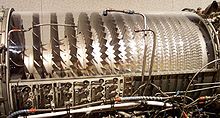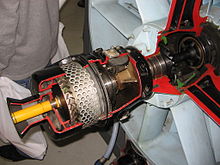- General Electric J79
-
"J79" redirects here. For British Halcyon class minesweeper, see HMS Scott (J79).
J79 J79 on display at the National Museum of the United States Air Force Type Turbojet National origin United States Manufacturer General Electric Aircraft Engines First run 20 May 1955 (first flight) Major applications F-104 Starfighter
F-4 Phantom II
A-5 Vigilante
B-58 HustlerNumber built >17,000 [1] Unit cost $624,727 (J79-GE-3, 1960)[2] Developed from General Electric J73 Variants General Electric CJ805 Developed into General Electric CJ805-23 The General Electric J79 is an axial-flow turbojet engine built for use in a variety of fighter and bomber aircraft. The J79 was produced by General Electric Aircraft Engines in the United States, and under license by several other companies worldwide
A simplified civilian version, designated the CJ805, powered the Convair 880, while an aft-turbofan derivative, the CJ805-23, powered the Convair 990 airliners and a single Sud Aviation Caravelle intended as a prototype for the US market.
Contents
Development
The J79 was developed in the 1950s as an outgrowth of the General Electric J73 engine program, originally called J73-GE-X24A, intended for reliable Mach 2 performance.
The first flight of the engine was on 20 May 1955 where the engine was placed in the bomb bay of a J47-powered B-45C (48-009). The J79 was lowered from the bomb bay and the four J47s were shut down leaving the B-45 flying on the single J79.[3] The first flight after the 50-hr qualification test was on 8 December 1955, powering the second pre-production Douglas F4D Skyray, with the J79 in place of its original Westinghouse J40 engine as part of the General Electric development and qualification program. The YF-104 was the next airplane to fly with the J79 followed by a re-engined Grumman F11F Tiger in a Navy-sponsored program to gain experience with the engine before the first flight of the F4H (F-4).
The J79 was used on the F-104 Starfighter, B-58 Hustler, F-4 Phantom II, A-5 Vigilante, and the IAI Kfir. It enjoyed a production run of more than 30 years. Over 17,000 J79s were built in the United States, and under license in Belgium, Canada, Germany, Israel, Italy, and Japan. A downgraded version of the F-16 Fighting Falcon with a J79 was proposed as a low-cost fighter for export, and though a prototype aircraft was flown, it found no customers.
The J79 was replaced by the late 1960s in new fighter designs by afterburning turbofans such as the Pratt & Whitney TF30 used in the F-111 and F-14, and newer generation turbofans with the Pratt & Whitney F100 used in the F-15 Eagle which offer better cruise fuel efficiency by moving unburned air around the core of the engine.
For their part in designing the J79, Gerhard Neumann and Neil Burgess of General Electric Aircraft Engines were jointly awarded the Collier Trophy in 1958, also sharing the honor with Clarence Johnson (Lockheed F-104) and the U.S. Air Force (Flight Records).[4]
Design
 The North American Eagle supersonic car display engine shows compressor blades smaller at each stage.
The North American Eagle supersonic car display engine shows compressor blades smaller at each stage.
The J79 is a single-spool turbojet with a seventeen-stage compressor with a novel arrangement of variable stator blades which allow the engine to develop pressure similar to a twin-spool engine at a much lower weight. Each blade is made largely of stainless steel. Each blade today costs several thousand dollars to replace. The compressor blades are mounted on disks (the first 7 being made of titanium) and spaced with corrosion-resistant (not stainless) steel spacers.[5]
In the F-104 and the F-4, the J79 makes a unique howling sound at certain throttle settings. The sound is thought to be due to airflow in the exhaust section of the engine being disturbed by the engine bypass flaps. This strange feature led to the NASA operated F-104B Starfighter, N819NA, being named Howling Howland.[6]
The turboshaft counterpart to the J79 is the LM1500, used for land and marine applications. Many J79 derived engines have found uses as gas turbine power generators in remote locations, in applications such as the powering of pipelines.
The J79 has two commercial derivatives: CJ805-3 (a non-afterburning engine, fitted with thrust reverser and sound suppressor), and the CJ805-23 (with a free-wheeling aft fan and thrust reverser) Most fitted to the Convair CV-880 and the Convair CV-990.
Variants and applications
- XJ79-GE-1
- Prototype. First ground static test run on 8 June 1954 produced 14,350 lbf with afterburner.[7]
- Flight test engines were designated YJ79-GE-1.
- J79-GE-2 and -2A
- Powered the F-4H-1 (F-4A) Phantom, 16,100 lbf (71.6 kN) of afterburner thrust.
- J79-GE-3
- Used in the YF-104A, F-104A and the F-11F-1F Super Tiger
- J79-GE3A
- YF-104A, F-104A and F-104B.
- J79-GE-3B
- F-104A and F-104B.
- J79-GE-5A
- B-58 Hustler 15,600 lbf (69.3 kN) with afterburner.
- J79-GE-7A
- F-104C, F-104D and F-104F.
- J79-OEL-7
- Licensed production GE-7 manufactured by Orenda Engines to power the Canadair CF-104.
- J79-GE-8, -8A and -8B
- A-5 Vigilante and F4H-1 (F-4B) with 16,950 lbf (75.4 kN) of afterburner thrust
- J79-GE-10
- F-4J, 17,900 lbf (79.379 kN) of afterburner thrust.
- J79-GE-11A
- F-104G and TF-104G. 15,600 lbf (69 kN) with afterburner. Many -11 engines were licensed manufactured in Europe as part of the large F-104 consortium production programme, Alfa Romeo, Fiat and Fabrique Nationale being the main suppliers for the project.
- J79-IHI-11A
- Licensed production GE-11A, built in Japan by Ishikawajima-Harima Heavy Industries Co., Ltd to power their similarly licensed built F-104J and F-104DJ Starfighters.
- J79-MTU-J1K
- Licensed built and improved version of the GE-11A manufactured by MTU Aero Engines in Germany.
- J79-GE-15
- F-4C, RF-4C, F-4D.
- J79-GE-17
- F-4E, 17,900 lbf (79.379 kN) of afterburner thrust.
- J79-GE-19
- Aeritalia F-104S; also retrofitted to F-104A's of the 319th FIS.
- J79-GE-J1E
- License-built in Israel by Bet Shemesh Engines Ltd. (BSEL)[citation needed] with 18,750 lbf (83.4 kN) afterburning thrust for the IAI Kfir.
Applications
- A-5 Vigilante
- B-58 Hustler
- F-4 Phantom II
- F-11F-1F Super Tiger
- F-16/79
- F-104 Starfighter
- IAI Kfir
- Convair 880
- Convair 990
- SSM-N-9/RGM-15 Regulus II
Land speed record cars
- Art Arfons' "Green Monster"
- Craig Breedlove's "Spirit of America - Sonic 1"
Specifications (J79-GE-17)
Cutaway of an air-start system of a General Electric J79 turbojet. The small turbine and epicyclic gearing are clearly visible.
General characteristics
- Type: Afterburning turbojet engine
- Length: 17.4 ft (5.3 m)
- Diameter: 3.2 ft (1.0 m)
- Dry weight: 3,850 lb (1,750 kg)
Components
- Compressor: 17-stage axial compressor with variable stator vanes
- Combustors: cannular
- Turbine: 3-stage
Performance
- Maximum thrust: 11,905 lbf (52.9 kN) dry; 17,835 lbf (79.3 kN) with afterburner
- Overall pressure ratio: 13.5:1
- Turbine inlet temperature: 1,210 °F (655 °C)
- Specific fuel consumption: 1.965 lb/(h·lbf) (200 kg/(h·kN)) with afterburner, 0.85 lb/(h·lbf) (87 kg/(h·kN)) at military thrust
- Thrust-to-weight ratio: 4.6:1 (45.4 N/kg)
See also
- North American Eagle
- United States military aero engine designations
- Related development
- General Electric CJ805
- Related lists
References
Notes
- ^ General Electric - Aviation History Retrieved: 7 April 2008
- ^ Pace 1992, p. 33.
- ^ Pace 1992 p. 67.
- ^ Collier Trophy winners, 1950-1959, National Aeronautic Association. Retrieved: 7 April 2008
- ^ AgentJayZ (2010). "Compressor Rotor II - Turbine Engines: A Closer Look". http://www.youtube.com/watch?v=xknOx-6_zqU. Retrieved April 22, 2011.
- ^ Bashow 1986, p. 16.
- ^ Pace 1992, p. 69.
Bibliography
- Neumann, Gerhard (June 1984). Herman the German. William Morrow & Co. p. 269. ISBN 0-688-01682-0. "The former enemy alien and Air Corps G.I. whose inventive skills and maverick management techniques made jet engine history"
- Pace, Steve. Lockheed F-104 Starfighter. Osceola, Wisconsin: Motorbooks International, 1992. ISBN 0-87938-608-8.
- Bashow, David L. Starfighter: A Loving Retrospective of the CF-104 Era in Canadian Fighter Aviation, 1961-1986. Stoney Creek, Ontario: Fortress Publications Inc., 1990. ISBN 0-919195-12-1.
- Gunston, Bill. Fighters of the Fifties. Cambridge, England. Patrick Stephens Limited, 1981. ISBN 0-85059-463-4.
- Williams, Nick and Steve Ginter "Douglas F4D Skyray". Simi Valley, California: Ginter, 1986. ISBN 0-942612-13-2.
External links
- General Electric Aviation, J79 page
- GE: The History of Aircraft Engines (CJ805 mentioned)
- Animation of J79 turbojet (German language)
General Electric aircraft engines Turbojets Turbofans Turboprops/Turboshafts Aeroderivative gas turbine engines † Joint development aeroenginesUnited States military gas turbine aircraft engine designation system Turbojets J30 · J31 · J32 · J33 · J34 · J35 · J36 · J37 · XJ38 · J39 · J40 · J41 · J42 · J43 · J44 · J45 · J46 · J47 · J48 · J49 · J51 · J52 · J53 · J54 · J55 · J56 · J57 · J58 · J59 · J60 · J61 · J63 · J65 · J67 · J69 · J71 · J73 · J75 · J79 · J81 · J83 · J85 · J87 · J89 · J91 · YJ93 · J95 · J97 · J99 · J100 · YJ101 · J102 · J400 · J401 · J402 · J403 · J700
Turboprops/
TurboshaftsT30 · T31 · T33 · T34 · T35 · T36 · T37 · T38 · T39 · T40 · T41 · T42 · T43 · T44 · T45 · T46 · T47 · T48 · T49 · T50 · T51 · T52 · T53 · T54 · T55 · T56 · T57 · T58 · T60 · T61 · T62 · T63 · T64 · T65 · T66 · T67 · T68 · T69 · T70 · T71 · T72 · T73 · T74 · T76 · T78 · T80 · T100 · T101 · T400 · T405 · T406 · T407 · T408 · T700 · T701 · T702 · T703 · T706 · T708 · T800
Turbofans TF30 · TF31 · TF32 · TF33 · TF34 · TF35 · TF37 · TF39 · TF41 · F100 · F101 · F102 · F103 · F104 · F105 · F106 · F107 · F108 · F109 · F110 · F112 · F113 · F117 · F118 · F119 · YF120 · F121 · F122 · F124 · F125 · F126 · F127 · F128 · F129 · F135 · F136 · F137 · F138 · F400 · F401 · F402 · F404 · F405 · F408 · F412 · F414 · F415
Lists relating to aviation General Aircraft (manufacturers) · Aircraft engines (manufacturers) · Airlines (defunct) · Airports · Civil authorities · Museums · Registration prefixes · Rotorcraft (manufacturers) · TimelineMilitary Accidents/incidents Records Categories:- General Electric aircraft engines
- Turbojet engines 1950-1959
Wikimedia Foundation. 2010.







